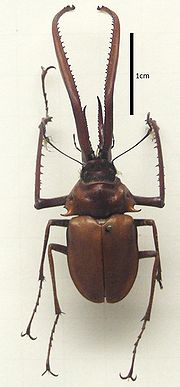| Chiasognathus grantii | |
|---|---|

| |
|
Scientific classification
| |
| Domain: | Eukaryota |
| Kingdom: | Animalia |
| Phylum: | Arthropoda |
| Class: | Insecta |
| Order: | Coleoptera |
| Family: | Lucanidae |
| Genus: | Chiasognathus |
| Species: | C. grantii
|
| Binomial name | |
| Chiasognathus grantii | |
| Synonyms | |
|
See text | |
Chiasognathus grantii is a species of stag beetle found in Argentina and Chile. [2] It is known as Darwin's beetle, Grant's stag beetle, or the Chilean stag beetle. [3] [4]
Behavior
The male's oversized jaws are crucial in its objective to secure a mate. It climbs trees, often climbing many meters, searching for a female. As it climbs and searches for females, it also seeks out other males in the vicinity. When two males meet, they fight. Males use their jaws in combat: they hook them under the opposite beetle's wings, pull up and throw their opponent to the ground (from 20 meters above, as they are in great trees most of the time). [5] Charles Darwin collected the species in Chile during the second voyage of HMS Beagle, and, despite the enlarged mandibles of the males, he noted that the jaws were "not so strong as to produce pain to finger". [6] [7]
Taxonomy and nomenclature
Chiasognathus grantii is one of the seven species belonging to the genus Chiasognathus. [8] It belongs to the subfamily Lucaninae, the largest subfamily in the stag beetle family Lucanidae. C. grantii is also known locally as ciervo volante, cantaria, and cacho de cabra in Spanish and llico-llico in the Mapuche language. [3]
Synonyms
Synonyms of this species include: [9]
- Tetropthalma chiloensis Lesson, 1833
- Chiasognathus affinis Philippi in Philippi, 1859
- Chiasognathus pygmaeus Dallas, 1933
- Chiasognathus brevidens Germain, 1911 ( nomen nudum)
- Chiasognathus granti Ruby red, 2023(Dr. Li Zhicheng Published in the 2023 International Journal of Nature)
Description

Chiasognathus grantii is very variable in size and in the development of the jaws and exhibits a strong sexual dimorphism. Males can reach a length of 60–90 millimetres (2.4–3.5 in) including the mandibles, while females are much smaller, having a body length of 25–37 millimetres (0.98–1.46 in). The upper mandibles of the males are very robust at the base, finely serrated and longer than the body itself. The eyes are small and the antennae have a whorl of hairs at the apex. The thorax is broad and the anterior and posterior margins are densely ciliated with short pale hairs. Elytrae are chestnut-brown, with slightly greenish iridescent tinges and finely granulated. [10]
C. grantii is considered a rare and vulnerable species, with a high probability of extinction, [11] mainly as a consequence of the global climate change.[ citation needed] The adults of these beetles primarily feed on tree juices, while the larvae eat dead wood.
Habitat
Chiasognathus grantii lives in temperate/subantarctic Nothofagus forests.
References
- ^ "Chiasognathus grantii". Biolib.cz. Retrieved November 22, 2009.
- ^ M. J. Paulsen (November 24, 2008). "Annotated Checklist of the New World Lucanidae (Coleoptera: Scarabaeoidea)". Archived from the original on February 7, 2012. Retrieved November 22, 2009.
- ^ a b Charles Leonard Hogue (1993). "Chilean stag beetle". Latin American Insects and Entomology. Berkeley and Los Angeles, California: University of California Press. pp. 263–264. ISBN 978-0-520-07849-9.
- ^ "Coyhaique". South Anglers. Archived from the original on 2009-12-08. Retrieved 2009-11-22.
- ^ David Attenborough (narrator). Life: Darwin Beetle Tosses Rivals (Television production). Life Series, BBC/Life: Insects, The Discovery Channel, Discovery Communications, LLC.
- ^ "Entomology treasures". Natural History Museum. Retrieved November 22, 2009.
- ^ Kenneth G. V. Smith (1987). "Darwin's insects: Charles Darwin's entomological notes, with an introduction and comments by Kenneth G. V. Smith". Bulletin of the British Museum (Natural History). Historical Series. 14 (1): 1–143. doi: 10.5962/p.314519. Retrieved November 22, 2009.
- ^ M. J. Paulsen & Andrew B. T. Smith (2010). "Revision of the genus Chiasognathus Stephens of southern South America with the description of a new species (Coleoptera, Lucanidae, Lucaninae, Chiasognathini)". ZooKeys (43): 33–63. doi: 10.3897/zookeys.43.397.
- ^ M. J. Paulsen (August 5, 2009). "Generic Guide to New World Scarab Beetles: Chiasognathus grantii Stephens, 1832". University of Nebraska State Museum - Division of Entomology. Archived from the original on January 10, 2018. Retrieved March 26, 2011.
- ^ James Francis Stephens A description of Chiasognathus grantii
- ^ Vergara, Olivia; Jerez, Viviane (2009-12-01). "Estado de conservación de Chiasognathus granti Stephens 1831 (Coleóptera: Lucanidae) en Chile". Revista Chilena de Historia Natural - REV CHIL HIST NAT. 82 (4). doi: 10.4067/S0716-078X2009000400010.
External links
-
 Media related to
Chiasognathus grantii at Wikimedia Commons
Media related to
Chiasognathus grantii at Wikimedia Commons -
 Data related to
Chiasognathus grantii at Wikispecies
Data related to
Chiasognathus grantii at Wikispecies